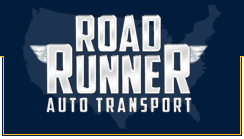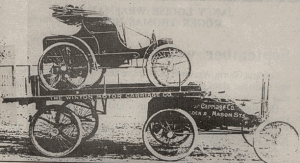
The trusted name in vehicle shipping for over 30 years!
- Track a Shipment
- Dealer Login
- Carrier Login
Speak with a shipping expert
(888) 777-2123

The History Of Car Shipping
Posted on 10/17/2019
Earliest auto transport
The demand for vehicle transport rises
Modern car shipping
Earliest auto transport
Alexander Winton and the first auto hauler
Car shipping can be traced all the way back to the invention of the automobile. Cars were originally extremely expensive luxuries imported from Europe in the late 19th century. There wasn’t a very high for demand for cars because of the expense. However, car shipping was still necessary because of the long distances between manufacturers, dealers and buyers.
Most car transportation was done through the railroads in the 19th century. Unfortunately, this was quite expensive and took an exceptionally long time with the American transportation infrastructure still in its infancy. So, car designer and inventor Alexander Winton went on to invent the first auto carrier in 1898 shortly after he was the first person to make a commercial sale of an automobile in the United States.
Winton was from Scotland but moved to America where he saw a great opportunity to design and sell his cars. Once he realized that transporting the cars via the railroad wasn’t affordable or timely enough and that driving each car to each of the buyers (located all across the country) individually wasn’t feasible either, he invented the semi-truck.
More specifically, he attached a cart with two wheels in the back with a flatbed on top to the back of one of his motor carriages (cars). He then placed a motor carriage he had sold on the cart and drove it to the buyer. You can see this in the picture below.

Photo credit: www.delphos-ohio.com
Henry Ford and mass automobile production
Some people are not aware of the fact that Henry Ford did not invent the automobile. He also didn’t invent mass production or the assembly line either. He did, however, invent the first car that people in America could afford.
At the time, cars cost over a thousand dollars, a price most Americans could not afford. Once Henry Ford invented the Model T and eventually incorporated the assembly line into its production, he was able to sell it for only three hundred dollars.
Once he did this, the automotive industry exploded. By 1928, there was almost one car in the United States for every four people.
The demand for vehicle transport rises
On the rails
As the world bought more cars in the 20th century, the need for auto transport grew by large margin. By the 1940’s railroads were scrambling to do whatever they could to fit as many cars as possible on the trains. However, just as was the case fifty years earlier, this was still way to expensive for most dealers and buyers.
Then in the 1950’s several car companies as well as transportation companies designed and started using two level auto carrying flat-cars for trains. This most notably included Volkswagen who had created a flatcar with two levels which could carry ten cars at a time.
This changed the game for car shipping. By 1960, there were even tri-level railroad carriers which were moving twelve cars at a time.
Auto transport in the air and the sea
It was also at this time that auto transport on the sea and in the air started to pick up as well. Large freight planes became more in demand and were used for shipping cars. However, this was, and still is the most expensive method of shipping a car.
Many cargo ships were modified to fit as many cars as possible in as little time as possible. This included interior ramps being constructed on the inside of the ships so that the cars could be driven directly from the dock to their place on the boat rather than needing to be moved by forklift or some other method once on the ship.
Auto Haulers
Most importantly, the actual auto haulers that you see out on the road continued to evolve through the years. After the first auto carrier was invented and successfully used by Alexander Winton, these trucks developed into four-place quad trailers by the late 1940’s.
Many of these auto carriers had some interesting designs too. For example, in the 1950’s many of them had ornate art-deco elements on the trailers. Some early auto carriers looked like tanks built in a junkyard for a post-apocalyptic world. It was the “wild west” when it came to these car haulers and seeing some of them is proof of that. One constant was the chassis and trailer setup, which is still used to this day on some carriers.
By the 1960’s we really started to see much more “traditional looking” auto carriers on the road. They were stripped down and carried up to eight cars, all in close carefully planned and set proximity.
Modern car shipping
Modern vehicle shipping is quite different than it used to be. When you look at the current auto transport process as a whole, you can see how far we’ve come in over a hundred years’ time. These days car carrier trucks do the majority of auto shipping with the obvious exception of overseas shipments.
You also have a bunch of companies, who are solely dedicated to auto transport. Back in the beginning, all car shipping was done through general freight companies. It’s better now because having companies strictly shipping vehicles only allows them to lower costs for the end consumer.
RoadRunner has been around for a while now and has the know-how and experience to ship your car to any where it needs to go in the United States. Get a free quote today!
Instant Car Shipping Quote
Calculate your car shipping rate in 3 easy steps!
The History Of Car Shipping
Posted on 10/17/2019
Earliest auto transport
The demand for vehicle transport rises
Modern car shipping
Earliest auto transport
Alexander Winton and the first auto hauler
Car shipping can be traced all the way back to the invention of the automobile. Cars were originally extremely expensive luxuries imported from Europe in the late 19th century. There wasn’t a very high for demand for cars because of the expense. However, car shipping was still necessary because of the long distances between manufacturers, dealers and buyers.
Most car transportation was done through the railroads in the 19th century. Unfortunately, this was quite expensive and took an exceptionally long time with the American transportation infrastructure still in its infancy. So, car designer and inventor Alexander Winton went on to invent the first auto carrier in 1898 shortly after he was the first person to make a commercial sale of an automobile in the United States.
Winton was from Scotland but moved to America where he saw a great opportunity to design and sell his cars. Once he realized that transporting the cars via the railroad wasn’t affordable or timely enough and that driving each car to each of the buyers (located all across the country) individually wasn’t feasible either, he invented the semi-truck.
More specifically, he attached a cart with two wheels in the back with a flatbed on top to the back of one of his motor carriages (cars). He then placed a motor carriage he had sold on the cart and drove it to the buyer. You can see this in the picture below.

Photo credit: www.delphos-ohio.com
Henry Ford and mass automobile production
Some people are not aware of the fact that Henry Ford did not invent the automobile. He also didn’t invent mass production or the assembly line either. He did, however, invent the first car that people in America could afford.
At the time, cars cost over a thousand dollars, a price most Americans could not afford. Once Henry Ford invented the Model T and eventually incorporated the assembly line into its production, he was able to sell it for only three hundred dollars.
Once he did this, the automotive industry exploded. By 1928, there was almost one car in the United States for every four people.
The demand for vehicle transport rises
On the rails
As the world bought more cars in the 20th century, the need for auto transport grew by large margin. By the 1940’s railroads were scrambling to do whatever they could to fit as many cars as possible on the trains. However, just as was the case fifty years earlier, this was still way to expensive for most dealers and buyers.
Then in the 1950’s several car companies as well as transportation companies designed and started using two level auto carrying flat-cars for trains. This most notably included Volkswagen who had created a flatcar with two levels which could carry ten cars at a time.
This changed the game for car shipping. By 1960, there were even tri-level railroad carriers which were moving twelve cars at a time.
Auto transport in the air and the sea
It was also at this time that auto transport on the sea and in the air started to pick up as well. Large freight planes became more in demand and were used for shipping cars. However, this was, and still is the most expensive method of shipping a car.
Many cargo ships were modified to fit as many cars as possible in as little time as possible. This included interior ramps being constructed on the inside of the ships so that the cars could be driven directly from the dock to their place on the boat rather than needing to be moved by forklift or some other method once on the ship.
Auto Haulers
Most importantly, the actual auto haulers that you see out on the road continued to evolve through the years. After the first auto carrier was invented and successfully used by Alexander Winton, these trucks developed into four-place quad trailers by the late 1940’s.
Many of these auto carriers had some interesting designs too. For example, in the 1950’s many of them had ornate art-deco elements on the trailers. Some early auto carriers looked like tanks built in a junkyard for a post-apocalyptic world. It was the “wild west” when it came to these car haulers and seeing some of them is proof of that. One constant was the chassis and trailer setup, which is still used to this day on some carriers.
By the 1960’s we really started to see much more “traditional looking” auto carriers on the road. They were stripped down and carried up to eight cars, all in close carefully planned and set proximity.
Modern car shipping
Modern vehicle shipping is quite different than it used to be. When you look at the current auto transport process as a whole, you can see how far we’ve come in over a hundred years’ time. These days car carrier trucks do the majority of auto shipping with the obvious exception of overseas shipments.
You also have a bunch of companies, who are solely dedicated to auto transport. Back in the beginning, all car shipping was done through general freight companies. It’s better now because having companies strictly shipping vehicles only allows them to lower costs for the end consumer.
RoadRunner has been around for a while now and has the know-how and experience to ship your car to any where it needs to go in the United States. Get a free quote today!
"I would definitely use RoadRunner Auto Transport again without a doubt. Excellent overall service from start to finish."
Trish A.
Miami, FL


"When I bought a car out of state I was unsure what to expect with the shipping. RoadRunner made everything so easy!"
Jenna D.
Lufkin, TX


"RoadRunner gave us a fair price and was able to pick up when we needed. Very professional from start to finish."
Sean T.
Brooklyn, NY


"We have used RoadRunner Auto Transport two times. Both times, the experience was nothing less than stellar."
Kate K.
San Diego, CA


Frequently Asked Questions
Get answers to some of the most commonly asked questions about the vehicle transportation process.








